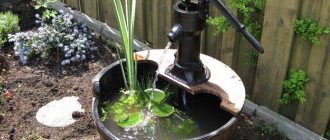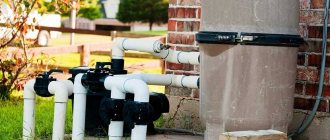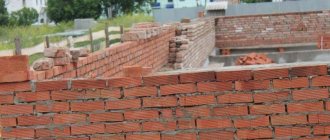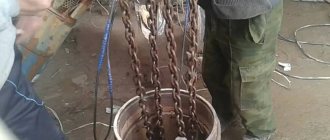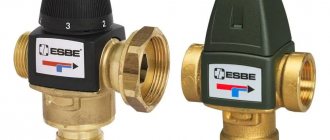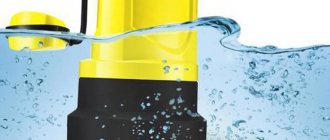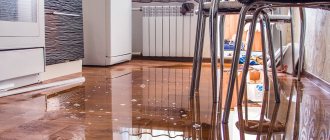Not everyone is able to organize an automatic water supply system for a country house, which includes the installation of pumping equipment. Often the main problem is financial, because to implement such a project you will have to spend a lot of money. As a result, many have to come to terms with reality and carry water in buckets from the well for irrigation and other needs. However, for some, this prospect prompts them to look for an alternative solution. For example, a hand pump is installed for water from a well. This is an ideal solution to automate the water supply process. Although it is difficult to obtain a large volume, it is better than carrying full buckets from a nearby street or transporting them from somewhere, which is even worse.
In this article we will tell you about the existing types of hand pumps. Looking ahead, we note that there are 4 main types, including piston, rod, membrane and vane. We will look at the features of each of them and will definitely talk about the arrangement of the well. In addition, instructions will be provided on how to make such a pump yourself. But first, let's get acquainted with the features of this equipment.
Features of hand pumps: advantages and disadvantages
A hand pump has its positive and negative qualities.
A hand pump means a special device that pumps liquid to the surface from a well. Physical effort is required to operate the lever mechanism. Unlike the automatic type, the water flow rate is much lower. But this lever mechanism has advantages over its counterpart. If there is no electricity supply at your dacha, then you will have an uninterrupted source of water, including clean drinking water.
The hand pump is especially convenient for those who cannot carry heavy buckets. In just a few presses of the lever you can get a glass of water. This device has both positive and negative features, consider them:
| pros | Minuses |
| There is no need to use expensive equipment. | Water is pumped only after pressing the lever mechanism. |
| Can be installed under almost any conditions. | Low level of productivity. Unlike analogues, liquid is supplied to the surface in a very small volume. |
| No electrical connection required. | |
| If some components fail, they are easy to replace. | |
| Unlike analogs (electric devices), a hand pump costs much less. | |
| If you really want to, you can do it yourself. | |
| Easy to use. | |
| The installation is quite simple. | |
Although you can make such a device for a well yourself, most people decide to buy ready-made products. This is explained by the fact that welding is used to manufacture the pump. Not everyone is able to make a high-quality weld, and as a result, the efficiency of the design is reduced to zero.
Installation recommendations
Correct installation of a pump to increase water pressure with automation will ensure the water needs of the apartment for many years. During the installation process, adhere to the following recommendations:
- For longer operation of the device, it is highly advisable to install a mechanical filter at the pump inlet. Thus, you will protect the equipment from foreign particles entering it;
- The device must be installed in a dry place in a heated room. At sub-zero temperatures, the water in the pump may freeze, damaging the inside of the device;
- The shut-off valve must be installed before the pump. This will make it possible to carry out equipment maintenance when the water flow is turned off;
- Gradually, during operation, the vibration acting on the pump can loosen the device, which can cause leaks in the places where it is attached. Therefore, first check the tightness of the connections.
A correctly selected and correctly installed pump to increase the working water pressure in the apartment water supply will solve your problems associated with low water pressure in an apartment of any number of floors.
Source: okanalizacii.ru
Pump classification
Hand pumps take on a different and even unexpected appearance.
Today you can often find water standpipes in courtyards or in the private sector. Such speakers have nothing in common with manual mechanical pumps. Why? In conventional water pumps, water pressure is created by pressure in the city water supply. In a mechanical pump, pressure is created through pressure, which must be constantly pumped up using physical effort.
All mechanical pumps are classified into 4 main groups:
- Piston.
- Rod
- Membrane.
- Winged.
Piston devices are used for sources up to 10 m deep. If the well depth is 30 m, then rod devices are ideal. Membrane ones are mainly used for pumping water in water supply systems. As for vane hand pumps, this is the most expensive device. It is a rotary mechanism in a housing with a suction pipe.
Also, hand pumps differ in operating mode and materials of manufacture. For example, some models can only be used in the summer. The housings of such pumps can be made of plastic. There are also metal models of devices that should be insulated for use in the winter.
Now we invite you to familiarize yourself in more detail with all types of similar devices used to lift water from a well.
Which column is better to buy for low water pressure?
In houses of the 60-70s, due to old risers and design flaws, the cold water pressure is initially weak. Low water pressure also occurs in private homes, especially when water supply is provided not through a station, but through a pressure column (a column with a container at the top).
In such situations, you should select a water heater that operates at minimum water pressure. Below are several models of instantaneous gas boilers that are capable of operating with low pressure in the pipeline:
- Zanussi GWH 10 Fonte - minimum pressure 0.15 bar. The burner power is manually adjusted from 50-100%. There is a display on the case indicating the heating temperature. Battery operated.
- BOSCH WR 10-2P is an atmospheric water heater that turns on at a pressure of 0.15 bar. Ignition is carried out using a piezoelectric element. Features high performance.
- Zanussi GWH 12 Fonte is a flow-through dispenser with electric ignition. Minimum pressure 0.15 bar. Battery operated.
- Neva 4510 is a domestic automatic dispenser designed to operate on liquefied and natural gas. Battery operated.
- Gorenje GWH 10 NNBW is another popular column that works with low water pressure from 0.15 bar. There is a display showing the heating temperature. Battery operated. Stably heats water with low cold water pressure.
The described models, despite the high build quality, are distinguished by their affordable budget price, ranging from 8-12 thousand rubles.
Source: AvtonomnoeTeplo.ru
Piston hand pump: device and features
Piston hand pump for water.
In this case, it is made of stainless steel, as already mentioned, a piston pump is used in cases where the water surface is located high. The maximum permissible limit for it is 10 m. If the mirror is deeper, the pump will not be able to lift the liquid to the surface.
Piston type device
The design of a piston pump in all its details.
The unit is based on a special piston, which is the main working unit. The piston itself is placed in the pipe and connected to the bottom of the device. Under the influence of forces on a special lever, the piston moves up and down. As soon as the piston is in water, it flows through the valve into the space above the piston. When the piston rises, it is pushed out through the outlet pipe.
The following nodes are visible from the outside:
- cylindrical body;
- drain pipe;
- lever arm;
- a rod extending into the cylinder.
The internal part consists of the following nodes:
- The piston is located inside the sleeve and comes into action under the influence of a lever mechanism.
- The stem is partially visible from the outside.
- Hole for water outlet.
- A pipe is connected to the pump from below through a fitting.
- Valves located on the piston itself.
In the diagram you can see all these components, as well as familiarize yourself with the operating principle of this pump:
The principle of operation of a piston pump is shown in this diagram.
It can be seen that the pump has 2 valves: one on the movable piston, the second on the stationary part, which opens under the influence of pressure and releases water. If it is not there, then pumping out water will be problematic. Typically, after using the pump, a small amount of liquid remains inside, as can be seen in the picture on the left side. When the piston rises, the valve opens, filling the inner cylinder.
In the figure in the center you can see that when the rod with the movable piston is lowered, the lower valve closes. At the same time, the valve on the piston opens and draws in liquid for its subsequent lifting up. When the piston moves completely down the cylinder, water flows completely from the lower chamber into the second.
Now in the diagram on the right side we see that the valve on the piston is closed and water comes out through the pipe. As you can see, the operation scheme is very simple. The only nuance of the operation of this pump is that with intensive use, the rubber seals on the piston quickly wear out. Sometimes valves fail. If the fluid contains small impurities, wear increases.
In what cases are they used?
A water pump to increase water pressure in an apartment is designed to create acceptable pressure in the water supply. If the norm is pressure in the region of 4 atmospheres, then in practice we record its decrease to a value of 1-1.5 and even lower. And to operate, for example, a washing machine, a pressure of at least 2 atmospheres is required. The Jacuzzi and shower cabin will not want to work at all at this pressure, since they are designed for 4 atmospheres. However, higher pressure is also dangerous for pipelines. Even at a pressure of 7 atmospheres, some elements of the water supply network can be damaged. Therefore, the pressure must be within certain limits and be stable .
It’s especially frustrating for residents of the upper floors during rush hours, when, coming home from work in the evening, it’s impossible to even wash properly. At the same time, residents of the lower floors have normal pressure. In this case, a circulation pump to increase water pressure, embedded directly into the inlet water main, can give residents a complete feeling of comfort.
Rod hand pump - its features
This type of pump is also known as a rod pump. It is used in cases where the water surface lies deeper than 12 meters. With such parameters, the piston type cannot cope. They are somewhat similar in design. The main working unit is the cylinder and piston. The pumping process is carried out practically according to the same scheme as in the case of the piston analogue. However, they differ in that the pump part itself is located directly in the aquifer. You can see its feature in the diagram:
The diagram shows the design of a rod pump in all its details.
The working cylinder is located directly in the water column. To install such a pump, you need a well with a casing pipe. The working cylinder is connected to the main part by a pressure pipeline, inside of which there is a rod or rod. It is he who sets the piston in motion. As for the presence of valves, there are also 2 of them, the first is located on the intake pipe of the cylinder, and the second on the piston.
Based on this diagram, it becomes clear that the supply to the top does not simply occur by suction. The working cylinder located in the aquifer creates a column. Each up and down movement of the piston creates pressure, replenishing the existing column with a new volume of liquid. Using this scheme, water can be raised even from a depth of 30 meters.
If we compare piston and rod units, then when using the latter, more effort is required to raise water to the surface. For this reason, the pump lever is often made longer. This allows you to achieve maximum piston stroke with less labor.
Such installations are more complex. This applies to both installation work and subsequent maintenance. However, if there is no electricity at your summer cottage, and the aquifer is located at a depth of 25–30 meters, then a rod pump is simply irreplaceable.
Diaphragm pump
A small diaphragm pump is convenient to use, since it can be moved as needed.
Such a pump means a special chamber that is separated by an elastic membrane. Hence its name - membrane. It can be used to lift water from a depth of up to 6 meters. This device has a round body with handles located above it.
The internal movable partition is connected to the handle. The pump design has an air chamber; it does not participate in any way in the transfer of water. There are 2 pipes at the bottom of the device. One of them is connected to the suction through a valve. The other acts as a supercharger.
When the membrane is pressed down, pressure increases in the chamber containing the liquid. As a result, the valve opens. When the rod is raised up, the membrane also rises up. Under pressure, water is released through the check valve. So, one valve is on the suction pipe, and the second is on the outlet pipe.
Metal or cast iron is used for their manufacture. One of the weak points of this pump is the membrane. With frequent use, it quickly breaks through. Moreover, over time, the membrane stretches and becomes elastic. Because of this, productivity drops to zero. Water may leak through the housing, this is if the membrane has broken. Replacing the membrane will not be much of a problem. But even despite this, diaphragm hand pumps have not gained widespread acceptance.
Video: homemade membrane principle unit
What to look for when choosing
When buying an electric water pump to increase pressure, check with your consultant for the following details:
- power. The more powerful the device, the more consumers will be able to enjoy its benefits. Consider the number of taps in the apartment and household appliances connected to the water supply;
- noise level, which varies between models;
- Certain pump models are designed for specific pipe sections. If you use a device for a water supply system with an inappropriate cross-section, the pump will work with overloads, and the pressure will be less than the calculated one;
- height of water level rise. A pump for water pressure in a water supply system, designed for a lower load, may simply not reach the required level of liquid (this item applies to the purchase of a pumping station);
- the size of the unit also matters, because sometimes it has to be installed in very small rooms where the entrance to the apartment is located;
- An important factor is the reliability and reputation of the manufacturer.
Vane pump
A vane pump can be used to pump water from a well.
Another type that we will describe is a vane pump. Such a pump is used not only for pumping clean water, but also petroleum products, sea water and other liquids. In the diagram, you can familiarize yourself with the vane pump in all details:
Design diagram of a vane pump
The device consists of the following components:
- Inlet valve.
- Valve seat.
- Screw.
- Frame.
- Screw.
- Impeller.
- Exhaust valve.
- Lever.
- Lid.
- Ring.
- Shaft.
- Sleeve.
- Oil seal packing.
- Cork.
To set the impeller in motion, a handle is fixed and rigidly mounted on the shaft. If the pump will not be used in winter, there is a plug on the body, which can be unscrewed to drain the water.
Procedure for commissioning a vane pump:
- The inside should be thoroughly rinsed with hot water. This is necessary, because a conservation lubricant is applied there. During the flushing process, the plugs from the suction and discharge pipes should be removed.
- Next you need to install the handle.
- Using 2 bolts, the pump should be fixed vertically.
- Then the pipeline is connected to the suction pipe. The pipeline must not be deformed under the influence of vacuum. Therefore, the ideal solution would be to use a metal pipe.
- The pressure pipeline is attached to the pump using the same principle. Please note that there is a hole in the pressure pipe through which liquid is poured into the device.
- If the depth of water intake is more than 1 meter, then a check valve must be attached to the suction pipeline. This will ensure normal operation of the pump.
- It is equally important to ensure complete tightness of the suction pipeline. Otherwise, the device will not work normally.
Installation of equipment in the apartment
Installation of a water pressure booster pump in an apartment is carried out in the following sequence:
The photo shows an installed booster pump for water.
- The pipe on which the pump will be installed is marked taking into account the length of the pump and adapters.
- The water in the apartment is shut off.
- The pipe is cut in two marked places.
- Threads are cut from the outside of the cut ends of the pipe.
- Adapters with internal threads are screwed onto the pipes.
- The included fittings are screwed into the adapters. When installing the pump, follow the instructions of the arrow on the device body, which shows the direction of fluid flow.
- A three-core cable is pulled from the electrical panel to the pump. It is advisable to equip a separate outlet near the pump, and connect the pump through a separate RCD.
- Turn on the pump and check it. Make sure there are no leaks from the fittings. If necessary, tighten the fasteners. For better sealing, use FUM tape, wrapping it around the thread.
Manual pump - features of choice and common models
We have discussed with you the main types of hand pumps that can be used to lift water from a well. If you can’t do it yourself, then you can consider ready-made models. When choosing, you need to consider the following nuances:
- An important selection criterion is the depth of the well. Compare this indicator with the parameters of the pumps.
- It is also important to know the performance, namely how much water it can pump out in one cycle.
- The diameter of the casing pipe is taken into account. It is important to keep one thing in mind here: if the diameter of the casing pipe is less than 100 mm, then you will not be able to insert a sucker rod pump pump assembly into it.
- You should know the degree of contamination of the source. Typically, the technical specifications are indicated in the product passport.
- Assess your strength, whether you can lift water from great depths on your own.
- Differences in installation methods. Therefore, immediately think about which installation method is acceptable in your case, for example, it could be a permanent installation or temporary, implying dismantling at the end of the warm season.
- Appearance also plays a significant role.
Considering these features, you can choose the pump that will ideally suit your needs. Now let's take a look at the most common models in the table:
| Pump name | Specifications | Price |
| "Dachny" | The device body is made of stainless steel. It is mainly used for pumping water from wells, wells, and reservoirs with a water surface of no more than 8 m. During operation, a check valve must be installed. The height of the pump with a raised rod is 0.75 m. The diameter of the connection to the pipe and the outlet hose is 1 inch. At one time, the pump pumps out a volume of 1.25 liters. Operation is allowed at temperatures not lower than +5°C. Device dimensions 750×500×125 mm. | From 6 thousand rubles. |
| NR-3M | Used for pumping water from wells, wells, reservoirs and other containers. The piston and cylinder of the unit are made of high quality plastic. Piston ring and valves made of rubber. Other elements are metal. This model is suitable for lifting liquid from a depth of no more than 2 m. However, it is also possible to operate at a depth of up to 9 m if a check valve is installed on the pipe at the bottom of the suction line. This pump weighs 5.5 kg. Device dimensions 540×180×550 mm. The diameter of the inlet and outlet pipes is ¾. | Around 2500 thousand rubles. |
| RN-01 NZh | This piston hand pump is used when raising water from a depth of no more than 9 m. The body of the device is made of stainless steel. Holder, black steel handle. Mainly colored green. A check valve must be installed at the suction. In one cycle (down–up) of pressing the lever, it dispenses up to 1 liter of water. The length of the lever allows the pump to be used by elderly women and those who have little strength. Pump dimensions 1000×150×870 mm. The installation weighs 8 kg. | Around 6.5 thousand rubles. |
| BSD | It is used to lift liquid from wells and wells. The depth of the aquifer is no more than 6 m. If you install a check valve on the suction line, you can raise water from a depth of up to 9 m. The pump can be installed on a flat surface due to the fact that the hole at the bottom allows the hose to be pulled out to the side. The height of the unit with the rod raised is 40 cm. By intensively pressing the lever, you can raise 22 l/min. Device dimensions 390×240×200 mm. The total weight of the installation reaches 7 kg. | From 3 thousand rubles. |
| BSAN | Like its analogues, it is used for pumping water from wells and wells. When using a check valve, water can be raised from a depth of up to 9 m. The pump body is made of cast iron. The flow rate is 28 l/min. Device parameters 650×240×160 mm. The total weight of the hand pump is 15 kg. | From 4 thousand rubles and more. |
| Series "K" | A pump is used to pump water without abrasive particles. Suction height up to 9 meters, provided that a check valve is installed at the end of the suction pipe. | Depending on the model, from 3 to 30 thousand rubles. |
| GBS-86 | A piston hand pump is used for pumping liquid from wells, wells and reservoirs. Vertically it is capable of lifting water from a depth of 15 m under a pressure of up to 1.5 atm. When installing a check valve, the suction height is up to 9 meters. With the rod raised, the height is 64 cm. In the delivery set you will receive a semi-assembled pump, a handle and a fitting for connecting a suction pipeline with a diameter of 25 mm. Device dimensions 530×240×160 mm. Weight 16 kg. Flow 28 l/min. | 6.5 thousand rubles or more. |
| D40 | Can be used for both clean water from a well/well and contaminated water. The diaphragm hand pump does not require pre-filling and is capable of lifting water from a depth of up to 6 meters. The body and pipes are made of cast iron. Valves and membrane made of oil and petrol resistant rubber. Device dimensions 250×250×650 mm. Installation weight 13.5 kg. Capacity is 50 l/min. | From 7 thousand rubles and above. |
| BSK | With minimal physical effort, this pump can lift water from a depth of up to 9 m when using a check valve at the end of the suction pipe. The body is made of cast iron using artistic casting. The pump is mounted using a flange. The height with the rod raised is 62 cm. There are 2 types in this series: BSK for wall mounting and BSKG for floor mounting. In the first case, the BSK capacity is 28 l/min. Its dimensions are 600×240×160 mm with a weight of 15 kg. The only difference between its analogue is the productivity, which is 30 l/min. They have a slight difference in cost. | From 6.2 thousand rubles. |
| NR-4-16 | Used for lifting from a depth of no more than 16 meters. Dispenses up to 1 liter of water per double stroke of the handle. The rod pump itself dives to a depth of 16 meters and pushes out the liquid. Weight is 127 kg with dimensions - 17560x230x1430 mm. | 27.6 thousand rubles or more. |
Here are several common options for hand pumps that will fully satisfy the water needs of your dacha.
Manufacturing and arrangement of an Abyssinian well (well) for a hand pump
A hand pump is ideal for installing it on an Abyssinian well.
For a hand pump, the ideal solution would be to make an Abyssinian well or borehole. Typically, such wells reach a depth of up to 9 meters. Based on these parameters, most of these devices were developed. At this depth there is usually a good aquifer, which makes it possible to provide a suburban area with drinking water. Moreover, this can be used for construction work.
If you watch a video about making an Abyssinian well, you will immediately notice that it is possible to make it yourself, however, there is a possibility that you will not cope with the task. And the reason for this will not be that you are a bad master, you may simply not be able to find water or other problems will arise. You can verify this by watching a video where all the rules of work were followed, but home craftsmen failed.
Video: making an Abyssinian well using the driving method - a bad experience
As can be seen from the video, all the details of the work were observed, but as a result, it was not possible to clog the pipe; it broke off. Although it is also possible that there simply was not enough experience in performing these works. Moreover, part of the pipe remained in the soil. With this in mind, it is worth considering everything carefully and weighing the pros and cons.
How to make a tripod for drilling
To properly make the simplest device for hanging a drill column with your own hands, it is enough to take 3 beams or logs that are connected at the top, forming a pyramid with a triangular base. You can also use metal pipes as supports. A winch is suspended from the center of the connection. Through an adapter in the form of a freely rotating spindle with a ring or clamp, a drill string is connected, in the upper part of which a collar is fixed.
Thus, to operate this device, at least 2 people are needed, but 3 are better, then two will rotate the drill, and the third will operate the winch.
To make it easier to work, we first dig a well or pit up to 2 meters deep. Flooring is placed on its bottom, and the walls are lined with boards to prevent crumbling. Leave the center of the hole free for drilling. The second flooring is laid on top, the tripod is installed with a support outside the pit or well.
As the drill sinks, the column is built up with new rods, the topmost of which is attached to the collar. To make the passage of hard rocks easier, you can add water to the well, but then it will be more difficult to understand when wet soil begins to flow, signaling that the aquifer has begun. After finishing the work, you can think about how to cover the well with your own hands. It is better to use an inspection hatch.
A suburban area without water is a small desert. Neither to plant a flowerbed, nor to equip a swimming pool, nor to other common and simply necessary benefits of civilization associated with water supply. There can be only one way out in such a situation - a well at the dacha with your own hands or to order. It all depends on whether you have money and the desire to work. If you have enough energy and enthusiasm, then such a troublesome task as installing a well in your country house will be up to you. Let's look at what kind of wells there can be and what is their difference.

